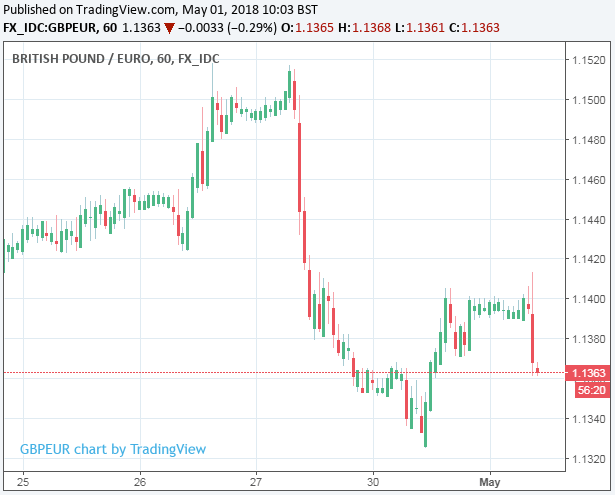British Pound hits Fresh Lows as UK Manufacturing PMI & Consumer Lending Data Disappoint
- Written by: James Skinner
-
- Manufacturing PMI signals UK industry seeing slowing growth.
- The current round of PMI surveys are crucial to narrative around GBP.
- Analyst says May rate hike not yet dead in water, scope for GBP recovery.

© freepeoplea, Adobe Stock
Pound Sterling extended its ongoing slide Tuesday as markets responded to the latest IHS Markit manufacturing PMI, which appeared to suggest the recent economic slowdown may have extended into the second-quarter.
May's release of the IHS Markit manufacturing PMI for April saw the index fall sharply to 53.9, which is down from 55.1 in the previous month and far below the consensus for a reading of 54.8 to be delivered. This marks a 17-month low and a fifth consecutive fall for the index.
The poorer-than-expected number was the result of slower rates of expansion in output, new orders and employment which, according to IHS Markit, stemmed from a softening of export demand during the recent month.
PMI surveys measure changes in industry activity by asking respondents to rate conditions for employment, production, new orders, prices, deliveries and inventories. A number above the 50.0 level indicates industry expansion while a number below is consistent with contraction.
"The latest Markit/CIPS Manufacturing Survey suggests that the sector struggled to regain much momentum at the start of Q2. The fall in the headline index from a downwardly-revised 54.9 in March to 53.9 in April took it to its lowest level since June 2016," says Paul Hollingsworth, a senior UK economist at Capital Economics.
Manufacturing has been a relative bright spot for the UK economy ever since the Brexit referendum after the double-digit fall in the Pound made British exports cheaper to buy.
The combined effect of this and a broad upturn in the global economy helped drive the British manufacturing sector to its longest run of growth since 1988 during the eight quarters to the end of 2017 but this boost now looks to be waning.
"The slowdown reflects weaker demand at home and overseas," says Samuel Tombs, chief UK economist at Pantheon Macroeconomics. "Markit’s manufacturing survey provides more evidence that the economy has fundamentally slowed this year, strengthening the case even more for the MPC to hold back from raising interest rates later this month."
The news confirmed a trend of declining expectations for an imminent interest rate rise at the Bank of England in coming months; it is these declining expectations that have in turn seen Sterling move lower.
Break over... "Soft" UK manufacturing PMI (53.9 versus 54.8 consensus) and sharp slowdown in consumer credit (least new borrowing since 2012) add to worries about growth and consumer confidence. Makes a Bank of England rate hike look even less likely - certainly not next week.
— James Knightley (@Knightleyeco) May 1, 2018
The Pound-to-Dollar rate was quoted 0.57% lower at 1.3692 following the release, which also represents a four-month low:

The Pound-to-Euro exchange rate fell to an intra-day low of 1.1358 following the news, before paring losses to 1.1383 at the time of this update.

"Weak UK data just keeps on coming. The Pound is off nearly 5% from the recent post-Brexit highs and a string of disappointing 1st tier economic figures is likely to continue weighing on Sterling," says Neil Jones, head of corporates and FIG at Mizuho Bank.
Sterling is now up by just 1.8% against the Dollar and 1.2% against the Euro for the year-to-date after having reversed gains that were previously in excess of 4% and 2.5% respectively.
"GBP/USD's pullback to the 1.3750-1.3800 area is consistent with markets fully pricing out a May BoE rate hike – which, inadvertently, we don't think that this is completely dead and buried. But we would need to see some bounce back in the April UK PMI readings this week to keep lingering hopes alive," says Viraj Patel, an FX strategist at ING Group.
Indeed, we could be looking at a delay from the Bank of England should data start picking up again over coming weeks, which it very well might. Afterall, the report from IHS Markit goes on to say:
"Companies reported that output was scaled up in response to higher intakes of new business, stronger client confidence, improved weather, new product launches and increased capacity. Output rose at consumer, intermediate and investment goods producers."
"Despite a slowdown in manufacturing growth during April, we shouldn’t lose sight of the fact that UK manufacturing is still currently at its highest level for a decade and output has increased for 21 months in a row," says Robert Gordon, CEO of Hitachi Capital UK. "As Brexit discussions gain pace, UK manufacturers should find themselves on a firmer footing to drive real growth and ensure the sector realises its potential."
Consumer Spending Slows
It's not just the manufacturing sector foreign exchange traders are eyeing.
Additional data out today, this time from the Bank of England, shows consumer lending fell sharply in March, consumer credit lending edged up by £254mn from February.
That was much weaker than a median forecast for growth of £1.45bn in a Reuters poll of economists. The drop in the annual growth rate was the sharpest from one month to the next since August 2009.
The BoE also said the number of mortgages approved for house purchase fell to 62,914 from 63,781 in February, slightly below economists’ forecasts of a drop to 63,000 in the Reuters poll.
Tuesday's data sets extend a growing and unwelcome narrative for Sterling, particularly in the context of recent events that have buffeted the currency and whittled the prospect of a May interest rate rise from the Bank of England down to below 20%. It is the first of three key releases this week, with similar surveys of the construction and services industries due Wednesday and Thursday.
"While GBP looked to be breezing its way through the early rounds of 2018, a couple of heavy sucker punches – landed by softer UK data and a more guarded Bank of England Governor – have knocked the Pound lower and left the currency on the ropes," Patel adds.
All eyes now turn to Thursday's key services PMI release as this should give an indication of where the all-important services sector, which accounts for over 80% of UK economic activity, is headed.
Last week data showed first-quarter GDP growth was just 0.1%, down from 0.4% at the end of 2017, which came after the economy was struck by a broad-based slowdown as well as a period of poor weather toward the end of February.
A downturn in construction activity was the sole reason for the slowdown in quarterly GDP growth in Q1. Momentum in the rest of the economy held up well. pic.twitter.com/tSkY1ylG5B
— Capital Economics (@CapEconUK) April 27, 2018
Details of a weaker growth performance came hard on the heels of March inflation data, which showed price pressures fading much faster than was expected by almost all economists, leaving the consumer price index sitting at just 2.5%.
This was far beneath the BoE forecast for inflation to average 2.8% during the first quarter and was what dealt the first blow to hopes, among currency traders, of an interest rate rise this month.
"We would expect renewed BoE tightening sentiment – in line with a 2Q rebound in UK data – to see a modest rebound in GBP/USD towards the low 1.40 level," Patel adds.
Following the inflation disappointment, BoE governor Mark Carney appeared to pour cold water all over the idea the Bank could raise rates again after the conclusion of its next meeting on May 10.
As a result, pricing in interest rate derivatives markets now implies a May 10 Bank Rate of just 0.51%, which suggests the market implied probability of a rate hike at this month's meeting is near to zero.
This is a substantial deterioration from the 0.58% implied Bank Rate that prevailed last Monday and the 0.66% rate that prevailed a fortnight ago. The actual Bank Rate is currently 0.5% but would rise to 0.75% if the BoE raised it again.
"Only a scenario in which the Bank of England comes out and says we’re not hiking again would cause further short-term pain for GBP. We don’t see that and if we can hold 1.37 – risk-reward for us favours GBP upside going into the May BoE meeting," Patel says.
Advertisement
Get up to 5% more foreign exchange by using a specialist provider to get closer to the real market rate and avoid the gaping spreads charged by your bank when providing currency. Learn more here.



